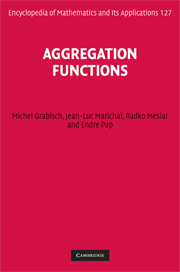Book contents
- Frontmatter
- Contents
- List of figures
- List of tables
- Preface
- 1 Introduction
- 2 Properties for aggregation
- 3 Conjunctive and disjunctive aggregation functions
- 4 Means and averages
- 5 Aggregation functions based on nonadditive integrals
- 6 Construction methods
- 7 Aggregation on specific scale types
- 8 Aggregation on ordinal scales
- 9 Aggregation on bipolar scales
- 10 Behavioral analysis of aggregation functions
- 11 Identification of aggregation functions
- Appendix A Aggregation of infinitely many arguments
- Appendix B Examples and applications
- List of symbols
- References
- Index
Appendix A - Aggregation of infinitely many arguments
Published online by Cambridge University Press: 05 March 2013
- Frontmatter
- Contents
- List of figures
- List of tables
- Preface
- 1 Introduction
- 2 Properties for aggregation
- 3 Conjunctive and disjunctive aggregation functions
- 4 Means and averages
- 5 Aggregation functions based on nonadditive integrals
- 6 Construction methods
- 7 Aggregation on specific scale types
- 8 Aggregation on ordinal scales
- 9 Aggregation on bipolar scales
- 10 Behavioral analysis of aggregation functions
- 11 Identification of aggregation functions
- Appendix A Aggregation of infinitely many arguments
- Appendix B Examples and applications
- List of symbols
- References
- Index
Summary
Introduction
Aggregation of infinitely but still countably many inputs is important in several mathematical areas, such as discrete probability theory, but also in non-mathematical areas, such as decision problems with an infinite jury, game theory with infinitely many players, etc. Though these theoretical tasks seem to be far from reality, they enable a better understanding of decision problems with extremely huge juries, game theoretical problems with extremely many players, etc.; see [333, 368, 416].
In Section A.2, based on [308], we discuss infinitary aggregation functions on sequences possessing some a priori given properties, such as additivity, comonotone additivity, symmetry, etc. On the other side we discuss infinitary aggregation functions A(∞) : [0, 1]ℕ → [0, 1] related to a given extended aggregation function A: ⋃n∈ℕ [0, 1]n → [0, 1], where special attention is paid to t-norms, t-conorms, and weighted arithmetic means. Note that the discussion of the infinitary arithmetic mean AM(∞) : [0, 1]ℕ → [0, 1] can be found in [141, 142].
General infinitary aggregation is discussed in Section A.3, thus extending the results from Section A.2. Note that in such case, some restrictions on the domain of aggregation functions is usually necessary. For example, to apply Lebesgue, Choquet or Sugeno integrals one should require the measurability of the input function to be aggregated.
Infinitary aggregation functions on sequences
We extend the notion of the usual aggregation function to the case of infinite inputs.
Information
- Type
- Chapter
- Information
- Aggregation Functions , pp. 397 - 409Publisher: Cambridge University PressPrint publication year: 2009
